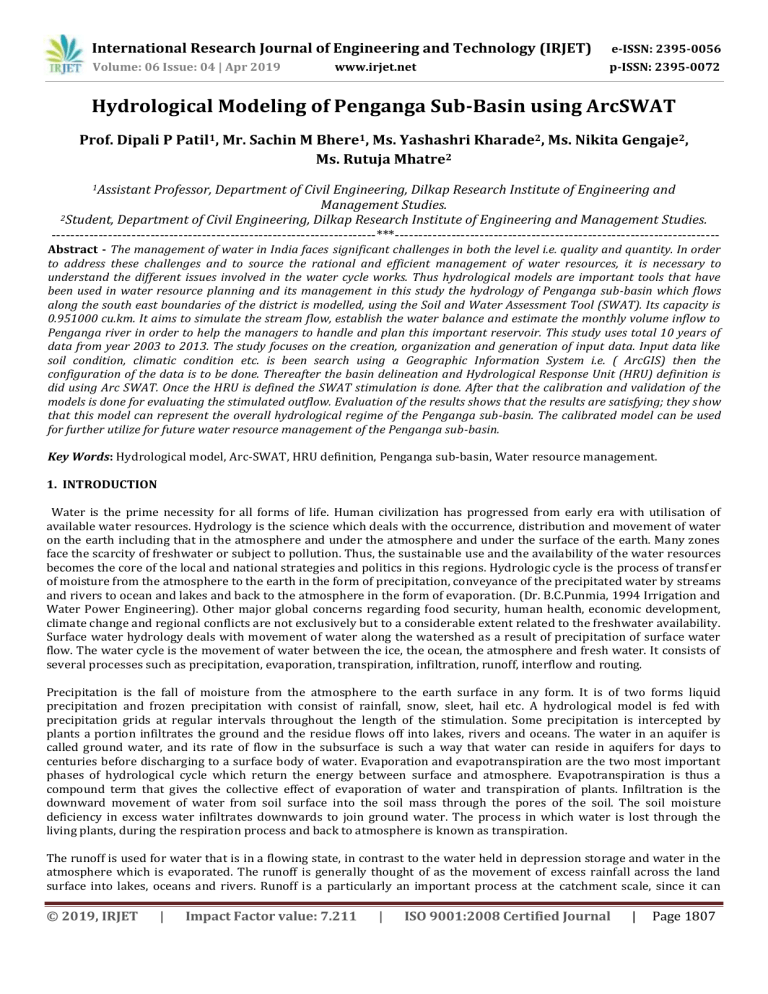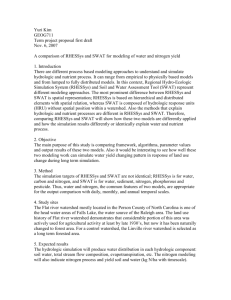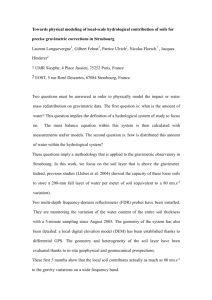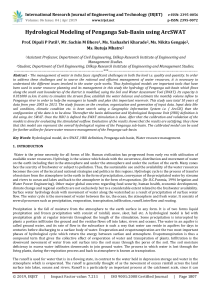IRJET-V6I4389
advertisement

International Research Journal of Engineering and Technology (IRJET) e-ISSN: 2395-0056 Volume: 06 Issue: 04 | Apr 2019 p-ISSN: 2395-0072 www.irjet.net Hydrological Modeling of Penganga Sub-Basin using ArcSWAT Prof. Dipali P Patil1, Mr. Sachin M Bhere1, Ms. Yashashri Kharade2, Ms. Nikita Gengaje2, Ms. Rutuja Mhatre2 1Assistant Professor, Department of Civil Engineering, Dilkap Research Institute of Engineering and Management Studies. 2Student, Department of Civil Engineering, Dilkap Research Institute of Engineering and Management Studies. ---------------------------------------------------------------------***--------------------------------------------------------------------Abstract - The management of water in India faces significant challenges in both the level i.e. quality and quantity. In order to address these challenges and to source the rational and efficient management of water resources, it is necessary to understand the different issues involved in the water cycle works. Thus hydrological models are important tools that have been used in water resource planning and its management in this study the hydrology of Penganga sub-basin which flows along the south east boundaries of the district is modelled, using the Soil and Water Assessment Tool (SWAT). Its capacity is 0.951000 cu.km. It aims to simulate the stream flow, establish the water balance and estimate the monthly volume inflow to Penganga river in order to help the managers to handle and plan this important reservoir. This study uses total 10 years of data from year 2003 to 2013. The study focuses on the creation, organization and generation of input data. Input data like soil condition, climatic condition etc. is been search using a Geographic Information System i.e. ( ArcGIS) then the configuration of the data is to be done. Thereafter the basin delineation and Hydrological Response Unit (HRU) definition is did using Arc SWAT. Once the HRU is defined the SWAT stimulation is done. After that the calibration and validation of the models is done for evaluating the stimulated outflow. Evaluation of the results shows that the results are satisfying; they show that this model can represent the overall hydrological regime of the Penganga sub-basin. The calibrated model can be used for further utilize for future water resource management of the Penganga sub-basin. Key Words: Hydrological model, Arc-SWAT, HRU definition, Penganga sub-basin, Water resource management. 1. INTRODUCTION Water is the prime necessity for all forms of life. Human civilization has progressed from early era with utilisation of available water resources. Hydrology is the science which deals with the occurrence, distribution and movement of water on the earth including that in the atmosphere and under the atmosphere and under the surface of the earth. Many zones face the scarcity of freshwater or subject to pollution. Thus, the sustainable use and the availability of the water resources becomes the core of the local and national strategies and politics in this regions. Hydrologic cycle is the process of transfer of moisture from the atmosphere to the earth in the form of precipitation, conveyance of the precipitated water by streams and rivers to ocean and lakes and back to the atmosphere in the form of evaporation. (Dr. B.C.Punmia, 1994 Irrigation and Water Power Engineering). Other major global concerns regarding food security, human health, economic development, climate change and regional conflicts are not exclusively but to a considerable extent related to the freshwater availability. Surface water hydrology deals with movement of water along the watershed as a result of precipitation of surface water flow. The water cycle is the movement of water between the ice, the ocean, the atmosphere and fresh water. It consists of several processes such as precipitation, evaporation, transpiration, infiltration, runoff, interflow and routing. Precipitation is the fall of moisture from the atmosphere to the earth surface in any form. It is of two forms liquid precipitation and frozen precipitation with consist of rainfall, snow, sleet, hail etc. A hydrological model is fed with precipitation grids at regular intervals throughout the length of the stimulation. Some precipitation is intercepted by plants a portion infiltrates the ground and the residue flows off into lakes, rivers and oceans. The water in an aquifer is called ground water, and its rate of flow in the subsurface is such a way that water can reside in aquifers for days to centuries before discharging to a surface body of water. Evaporation and evapotranspiration are the two most important phases of hydrological cycle which return the energy between surface and atmosphere. Evapotranspiration is thus a compound term that gives the collective effect of evaporation of water and transpiration of plants. Infiltration is the downward movement of water from soil surface into the soil mass through the pores of the soil. The soil moisture deficiency in excess water infiltrates downwards to join ground water. The process in which water is lost through the living plants, during the respiration process and back to atmosphere is known as transpiration. The runoff is used for water that is in a flowing state, in contrast to the water held in depression storage and water in the atmosphere which is evaporated. The runoff is generally thought of as the movement of excess rainfall across the land surface into lakes, oceans and rivers. Runoff is a particularly an important process at the catchment scale, since it can © 2019, IRJET | Impact Factor value: 7.211 | ISO 9001:2008 Certified Journal | Page 1807 International Research Journal of Engineering and Technology (IRJET) e-ISSN: 2395-0056 Volume: 06 Issue: 04 | Apr 2019 p-ISSN: 2395-0072 www.irjet.net recharge reservoirs that may subsequently recharge draining into a reservoir in that period. It occurs when the rate of precipitation exceeds the rate of infiltration at the soil surface or when soil is saturated. The runoff rises significantly as the vegetation cover falls below 30% the bars of the soil produce a large runoff coefficient. Groundwater is the water that occurs below the surface of Earth, where it occupies all the part of the void spaces in soil or geologic strata. Natural groundwater fluxes are Typically slow; water may reside in an aquifer for few hours or for hundred of years. The groundwater is also called as subsurface water to distinguish it from surface water, which is found in large bodies like the oceans and lakes which flows overland in streams. Most groundwater comes from precipitation. Precipitation infiltrates below the ground surface into the soil zone. Groundwater continues to descend until, at some depth, it merges into the zone of dense rock. The process of precipitation replenishing the groundwater supply is known as recharge. Natural outflows of the groundwater take place through the springs and the riverbeds when the pressure of groundwater is higher than that of the atmospheric pressure in the vicinity of the ground surface. At the catchment scale, however, where the streams aquifer interactions are relatively the rapid and substantial, the average groundwater fluxes are relatively fast moving. Modelling methods have been widely used for over 40 years for a variety of purposes, but almost all the modelling tools have been primarily developed for humid area applications. The arid and the semiarid areas have been particular challenges that have received little attention. The development of models has gone hand-in-hand with the developments in computing the power. While the models originated in 1930s and could be used with the hand calculation, the first hydrological models for the continuous simulation of rainfall-runoff processes emerged in the 1960s, when the computing power was sufficient to represent the land-phase processes in a simplified way. The relationship between models and data is fundamental to the modelling task. Now-a-days, the study of the watershed’s water resources requires use of the methods and the technologies that make it possible to combine the several elements, namely the watershed topography, climate change, nature of the soil and impact of human beings on the hydrological balance through the use of soil (ARPN Journal of Engineering and Applied Sciences). SWAT has been adjudged by researches as computationally efficient in its prediction. It has a reliability which confirmed in several areas around the world (Alexandria Engineering Journal). SWAT model was applied in large scale to evaluate the hydrological processes in Penganga river. The models have a parameter, which are numerical measures of a property or characteristics that are constant under the specified conditions. The application of a model like SWAT requires a large number of spatial and temporal data of different types and sources, collection and use of these data makes the use of SWAT difficult (APRN Journal of Engineering and Applied Sciences). A lumped model is the one in which the parameters, inputs, and outputs are spatially averaged and take a single value for the entire catchment. The tasks for which the rainfallrunoff models are used are diverse, and the scale of applications ranges from the small catchments, of the order of a few hectares, to that of the global models. However the modelling approach adopted will, in general, depend on the required scale of the problem, the type of catchment, and the modelling task. 2. Materials and Methods The Soil and Water Assessment Tool (SWAT) is a continuous, long term, physical based conceptual model. This model operates at basin scale on daily time step (Arnold et al., 1998, 2000; Neitsh et al., 2001 ). Soil and Water Assessment Tool (SWAT) is applied to model the hydrology of Penganga sub-basin. The methodologies used in this study include a description of the study area, hydrological model and the spatial dataset which is used in the simulation (S. M Ghoraba) 2.1 Description of the study area Penganga River is a major tributary of Wardha river and it rises in the Ajantha range. The Penganga River is the chief river of the Buldhana district, Hingoli district, Nanded district, Yavatmal district, Chandrapur district, Washim district in the Maharashtra state in India flows along the South East boundaries of the district. The total length of the river is 676km (420 mi). It lies between 20.375422 North latitudes and 76.332892 East longitude (decimal degrees). The district has an area of 13582 sq.km. (4.41 percent of the state) and a population of 2077144 (2.63 percent of the State). The density of population is 153 persons per km2 which is less than 257 persons per km2 for the state as whole. The central portion is a plateau with very steep sides and attains an elevation of between 300 and 600 metres above the mean sea level. This valley varies between 65-80 kilometers in width. The small part of it that belongs to Yavatmal district forms a belt of plain from 8 to 22 km in width along the northern district boundary. The average monthly precipitation is about 114.6458mm, most of which occurs during July-October. The average volume inflow from Penganga sub-basin is estimated at 275.0873 mm³/month, from 2003 to 2013 according to a gauged point on the location. © 2019, IRJET | Impact Factor value: 7.211 | ISO 9001:2008 Certified Journal | Page 1808 International Research Journal of Engineering and Technology (IRJET) e-ISSN: 2395-0056 Volume: 06 Issue: 04 | Apr 2019 p-ISSN: 2395-0072 www.irjet.net Figure 1: Location Map of Penganga sub-basin 2.2 Description of SWAT model The Soil and Water Assessment Tool (SWAT) is a continuous, long term, physical based conceptual model. This model operates at basin scale on daily time step (Arnold et al., 1998, 2000; Neitsh et al., 2001). It uses a command structure for routing runoff and chemical through watershed. It is developed by Agricultural Research Services of United States Department of Agriculture to predict the impact of land management practices on water, sediment, and agriculture chemical yields in large and complex watersheds with varying soils, land use, and management conditions over long periods of time, (S.M. Ghoraba). It is a hydrologic model with Arc-map GIS interface which has been developed by the USDA-ARS and the Black land Research and Extension Centre (Arnold et al., 1998). SWAT was developed from an earlier continuous time step model named Simulator for Water Resources in Rural Basins (SWRRB) (Williams et al., 1985, Arnold et al., 1990) which simulated non-point source loading from watershed. In the SWAT model, the catchment is primarily divided into sub-basins or sub-watersheds based on topographic criteria followed by further division into series of HRUs i.e. Hydrological Response Units on the basis of unique soil, slope and land use combination. Simulations can be carried out for components of hydrological cycles, nutrient cycles and sediment yield and then aggregated for the sub-basins. The SWAT model provides the users with various options when simulation is conducted for the hydrological processes, which can be selected based on the data availability. Generally water enters in the form of precipitation into the SWAT watershed system. In the model flow routing and water quality parameters is carried out on the basis of HRU to each sub-basin and eventually to the outlet of watershed. ArcSWAT (Arc GIS-SWAT) is the latest available version which is used as an interface between ArcGIS and the SWAT model. Arc-SWAT version 2.3.4 which was built for Arc-Map 10.2 is used in this study. Spatial data (DEM, soil and land use ) are used in the pre- processing phase and fed into the SWAT model through the interface. The land cover and soil make important responding units and the same is accomplished by SWAT model by subdividing the watershed into the areas having unique land use soil combination which is called as the Hydrological Response Units (HRU) during the process of the runoff generation. SWAT requires assortment of input data layers for the model setup and watershed simulations. The topography of the watershed is defined by a Digital Elevation Model (DEM) which is used to calculate the sub-basin parameters such as slope and to define the stream network. The soil data is required to define the soil characteristics and attributes. The land use and land cover data provide the vegetation information on ground and their ecological processes in lands and soils. Climate, precipitation and stream flow data are sourced and prepared according to the SWAT input requirements. The hydrologic cycle of the SWAT model is based on the water balance equation, which considers the unsaturated zone and the shallow aquifer above the impermeable layer as a unit. Eq. (1) is the important equation to predict the watershed of the hydrology used by SWAT. Where it is the time in days, SWt and SWo are the final and initial soil water content respectively (mm), R_day is amount of precipitation on day i (mm), Qsurf is the amount of surface runoff on day i (mm) , Qgw is the amount of return flow on day i (mm). (1) © 2019, IRJET | Impact Factor value: 7.211 | ISO 9001:2008 Certified Journal | Page 1809 International Research Journal of Engineering and Technology (IRJET) e-ISSN: 2395-0056 Volume: 06 Issue: 04 | Apr 2019 p-ISSN: 2395-0072 www.irjet.net The estimation of surface runoff can be performed bye the model using the Soil Conservation Service (SCS) curve number method, (S.M.Ghoraba) This method is widely used for the prediction of approximate amount of runoff from a given rainfall event. The SCS curve number equation is (2) Where it is the daily surface runoff (mm),Rday is the rainfall depth for the day (mm), and S is the retention parameter (mm). The retention parameter S and the prediction of lateral flow by SWAT model are define in Eq. Where CN1 is the moisture condition I curve number, CN2 is the moisture condition II curve number, and CN3 is the moisture condition III curve number. Lateral flow is predicted by Where = lateral flow (mm/day); s=drainable volume of soil Water per unit area of saturated thickness (mm/day); SC = saturated hydraulic conductivity (mm/h) ; L =flow length(m), = slope of the land, 2.3 Digital Elevation Model (DEM) The SRTM DEM of 30 m resolution (Bhuvan nrsc) was processed for the extraction of flow direction, flow accumulation, stream network generation and delineation of the watershed and sub-basins, The topographic parameters such as terrain slope, channel slope or reach length were derived from the DEM. Figure 2: Digital Elevation Model (DEM) 2.4 Land Use Land Cover Change in land use and vegetation affect the water cycle and its influence is a function of the density of plant cover and morphology of plant species. © 2019, IRJET | Impact Factor value: 7.211 | ISO 9001:2008 Certified Journal | Page 1810 International Research Journal of Engineering and Technology (IRJET) e-ISSN: 2395-0056 Volume: 06 Issue: 04 | Apr 2019 p-ISSN: 2395-0072 www.irjet.net Figure 3: Land use Land cover Map The land-use/ land-cover data is obtained from Decadal Map and used in this study. Thirteen classes are identified which contains Water: 1.08%, Wetlands-mixed: 0.01%, South Western us (arid) Range: 0.38%, Range-Brush: 10.25%, Agricultural Land-Generic: 0.81%. The land-use classes are converted into SWAT classes and are defined using lookup tables. 2.5 Soil Data The soil map, was obtained mainly from FAO (Food and Agricultural Organization). The soils are compared with the watershed area to use their properties to define HRUs. Five soils are delineated in the catchment such as Shallow coarse soil: 8.60%, Medium black soil: 5.65%, Deep black soil: 2.87%, Clayey medium black soil: 7.06%, Clayey Lumi: 74.90%. Figure 4: Soil Map 2.6 Meteorological data The meteorological data was obtained from Global Map from the year 2003-2013. The precipitation in 2003 was 101.28mm and in 2013 it was 39.41mm. SWAT automatically read the data from 3 rain gauge stations which includes rainfall, temperature, relative humidity etc. This region was flooded in 2013. © 2019, IRJET | Impact Factor value: 7.211 | ISO 9001:2008 Certified Journal | Page 1811 International Research Journal of Engineering and Technology (IRJET) e-ISSN: 2395-0056 Volume: 06 Issue: 04 | Apr 2019 p-ISSN: 2395-0072 www.irjet.net 2.7 Model simulation Hydrologic modelling of Penganga sub-basin was carried out using the Arc-SWAT version 10.2. After preparing the data files and completing all the model inputs, the model is ready for simulation. The simulation is done for the period of 10 years from 2003-2013 which is the same period of availability of climate data. The model is simulated many times by changing the evapotranspiration calculation method and the value of hydrological parameters that ranked by the model to get best match between the model output and observed flow data. 2.8 Model Efficiency There are many methods to assess and evaluate the accuracy of results produced by the model. The validation were carried out using Coefficient of Determination (R²) (S.M.Ghoraba). 2.9 coefficient of Determination (R2) It is the good method to signify the consistency among observed and simulated data by following best fit line. It ranges from 0 to 1.0 with higher values indicating less error variance, and the values greater than 0.5 are acceptable. (S.M.Ghoraba). 3. Results and Discussion Model validation is indispensable for simulation process, which are used to assess Model prediction results. The details, discussions and model evaluation are given as follows 3.1Model validation Physically based distributed watershed model should be validation before they are made use in the simulation of hydrological processes. This is to reduce the uncertainty associated with the model prediction. Validation was performed by comparing the simulated and observed surface runoff. After achieving a reasonable runoff data, the same value of validation. The available measurements were used for comparison with the predicted result in order to test the SWAT simulation efficiency. Validation took place in yearly where outflow data are existed form 2003 to 2013. For validation, the result of flow shows a good correlation of observed and model simulation as represented in fig Figure 5: Comparison of monthly observed and simulated stream flow The average annual flow for the simulation is m³/s whereas the observed flow during the same period is about m³/s which show very close similarity. The results suggest that the model can, very well, be used to predict the average annual values of river flow. The statistic evaluators showed a good correlation between the annually observed and simulated river discharge as follows. The values of Coefficient of Determination (R²) for the validation recognize the accuracy of the results as shown in fig. 4. The value of R² test is 0.9082 for validation. It indicate that the model results produced for the flow are very good. © 2019, IRJET | Impact Factor value: 7.211 | ISO 9001:2008 Certified Journal | Page 1812 International Research Journal of Engineering and Technology (IRJET) e-ISSN: 2395-0056 Volume: 06 Issue: 04 | Apr 2019 p-ISSN: 2395-0072 www.irjet.net Figure 6: Comparison of simulated and observed Discharge The fig. 6 shows relation between observed and simulated data which coincide each other. Discharge increases from June to September and decreases from January to May. Figure 7: Average Monthly Evapotranspiration from 2003-2013 The fig.7 shows average monthly evapotranspiration from 2003-2013. The rate of evapotranspiration is reducing by 0.01 cm/year. Figure 8: Average Monthly Sedimentation from 2003-2013 The fig. 8 shows average monthly sedimentation from 2003-2013. The rate of sedimentation increases as the rate of evapotranspiration decreases. 4 Conclusions The Geographic Information System (GIS) and Remote sensing has a vital role in hydrological modelling of watershed basin and it helps in studying of basin storage. The SWAT-2012 model is used to validate in the Penganga sub-basin for quantifying the impact on hydrological basin. The sensitivity analysis of the model to sub-basin delineation and HRU definition showed that the flow is more sensitive to the HRU definition than the sub-basin discretization effect. The hydrological basin storage analysis showed that discharge is an important component for quantifying the basin storage of reservoir. The Conclusion obtained for the hydrological simulation of Penganga sub-basin are: © 2019, IRJET | Impact Factor value: 7.211 | ISO 9001:2008 Certified Journal | Page 1813 International Research Journal of Engineering and Technology (IRJET) e-ISSN: 2395-0056 Volume: 06 Issue: 04 | Apr 2019 p-ISSN: 2395-0072 www.irjet.net SWAT is useful to demonstrate hydrological model by 0.9082 coefficient of correlation (R²) in Penganga river. Over Penganga river the rate of evapotranspiration is reducing by 0.01cm/year. In results, we observed the rate of sedimentation is increases as the rate of evapotranspiration decreases. So, the soil erosion is increased as the same rate of sedimentation due to large deforestation over Penganga river or climatic changes. The result can help water commission of India in future for the development of the basin area with respect to water storage in reservoir due to sediment, water demand, and water supply. Thus we can conclude that hydrological modelling and sediment analysis of Penganga sub-basin is significant. References [1] ISPRS Technical Commission VIII Symposium, 09-12 December 2014, Hyderabad, India. Simulation of surface runoff for Upper Tapi sub catchment area using SWAT. [2] International Journal of Water Resources and Environmental Engineering Vol. 1(1), pp.001-010, October, 2009. Hydrological Modelling of Kihansi river catchment in South Central Tanzania using SWAT model. [3] Anita Nag, K. P. (2013). Hydrological Modelling of Watershed using HEC-HMS software and Arc-GIS. International Journal of Advance Scientific and Technical Research, 2 (3), 313-319. [4] Arbind K Verma, M.K. (2012). Evolution of Arc-SWAT model for Streamflow Stimulation. 2012 International SWAT Conference, (pp . 1-29). [5] Bouraoui, F. (1996). ANWSERS 2000: Runoff and Sediment transport model. Journal of Environmental Engg, 122 (6). [6] Bir Singh Dhami, A. P. (2013). Comparative Review of Recently Developed Hydrologic Models. Journal of Indian Water Resources Society, 33 (3), 34-42. [7] J. Earth Syst. Sci. 124, No. 7, October 2015, pp. 1517-1529. Evaluating the influence of spatial resolutions of DEM on watershed runoff and sediment yield using SWAT. [8] International Journal of Geology, Earth & Environmental Sciences ISSN:2277-2081 (Online) An Open Access, Online International Journal Available 2014 Vol.4 (1) January-April, pp.224-235/Khare et al. Hydrological Modelling of Barinallah Watershed using Arc-SWAT model. [9] ARPN Journal of Engineering and Applied Sciences VOL. 12,NO. 23, December 2017.Using GIS and SWAT model for Hydrological modelling of oued laou Watershed. [10] David J H Blake, R. P. (2006). Simulation Analysis Lower songkhram river basin, Thailand. Mekong etland Biodiversity Conservation and Sustainable use programme, Bankok, Thailand, 121 pp. [11] Dr .Seema Jagtap, D. K. (2017). Rainfall runoff modelling using soft computing techniques. IJRAET, 5(2). [12] Francisco Olivera, M. V. (2006). ArcGIS-SWAT: A Geodata Model and GIS Interface for SWAT. Journal of the American Water resources Association, 295-309. [13] International Journal of Advanced Remote Sensing and GIS 2015, Vol. 4, Issue 1, pp. 1323-1333. Hydrological Modelling of Poondi sub-watershed using Arc-SWAT. [14] Hydrological Modelling in the Manas river basin using SWAT driven by CMADS. Tehnicki vjesnik 24, 2(2017), 525534. © 2019, IRJET | Impact Factor value: 7.211 | ISO 9001:2008 Certified Journal | Page 1814 International Research Journal of Engineering and Technology (IRJET) e-ISSN: 2395-0056 Volume: 06 Issue: 04 | Apr 2019 p-ISSN: 2395-0072 www.irjet.net [15] Ilias Semlali. L. O. (2017). USING GIS AND SWAT MODEL FOR HYDROLOGICAL MODELLING OF OUED LAOU WATERSHED (MOROCCO). APRN Journal of Engineering and Applied Sciences, 12 (23), 6933-6943. [16] J. E. Nash, J. S. (1970). Riverflow Forecasting Through Conceptual Models Part-I Discussions anad Principles. Journal of Hydrology, 282-290. [17] Kaleab Habte Michael Mamo, M.K. (2013). Runoff and Sediment modelling using SWAT in Gumera catchment, Ethopia. Open journal of modern hydrology, 3, 196-205. [18] M, D. S. (1997-98). Daily rainfall runoff modelling of Ruhikulya river, Orissa. National institute of hydrology, Roorkee. [19] Neitsch S. L, A. J. (2011). Soil and Water Assessment Tool Theoretical Documentation: Version 2009. College of agriculture and life sciences. [20] N S Raghuwanshi, R.S. (2006). Runoff and sediment yield modelling using ANN, upper Siwane river, India. Journal of hydrologic engg , 11(1). [21] KIM,L.N. (2010). Assesing the impacts of land use /land cover changes and practices on water discharge and sedimentation using GIS and SWAT: case study in Dong Nai watershed Vietnam. International Synposium on Geoinformatics for Spatial infrastructure development in Earth and Allied science, 1-13. © 2019, IRJET | Impact Factor value: 7.211 | ISO 9001:2008 Certified Journal | Page 1815





